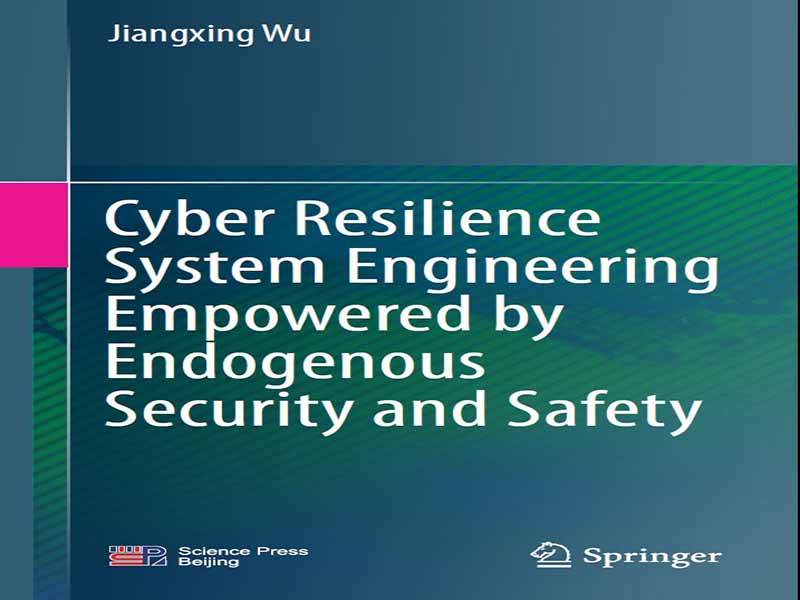- عنوان کتاب: Cyber Resilience System Engineering Empowered by Endogenous Security and Safety
- نویسنده/انتشارات: Jiangxing Wu
- حوزه: امنیت سایبری
- سال انتشار: 2025
- تعداد صفحه: 533
- زبان اصلی: انگلیسی
- نوع فایل: pdf
- حجم فایل: 7.25 مگابایت
جایزه نوبل فیزیولوژی یا پزشکی سال ۲۰۲۲ به دانشمند سوئدی، سوانته پیبیاو، به خاطر اکتشافاتش در مورد انقراض ژنوم انسان باستانی و تکامل انسان اهدا شد. در سال ۱۹۹۷، پیبیاو و همکارانش پس از توالییابی موفقیتآمیز DNA میتوکندری نئاندرتالهایی که ۳۰۰۰۰ سال پیش منقرض شدند، پیشگام پالئوژنومیک شدند. شواهد تحقیقاتی موجود نشان میدهد که اگرچه نئاندرتالها دهها هزار سال پیش از زمین ناپدید شدند، اما نسل آنها تا به امروز از طریق نژادهای مختلف انسانی تولید مثل کرده است. در سال ۲۰۲۱، محققانی از مونترال کشف کردند که ژنهای نئاندرتال بر سیستم ایمنی انسانهای مدرن تأثیر میگذارند. در میان آنها، ژنی به نام HLAclassl دارای توانایی ضد ویروسی قوی است که ایمنی انسانهای مدرن را افزایش میدهد. از این رو، نویسنده به نظریه محاسبهپذیری تورینگ-چرچ-گودل و مدل مهندسی ماشین تورینگ – معماری فون نویمان کامپیوتر دیجیتال مدرن – فکر کرد. به عنوان ژنی با توانایی بقای بسیار قوی، این ژن دهههاست که پیشرفت جامعه بشری را در زمینه دیجیتالی شدن، هوش، شبکهسازی و اطلاعاتی شدن، به طور عمیقی ارتقا داده است. متأسفانه، در حالی که چشماندازهای توسعه نامحدودی را برای جامعه بشری ایجاد میکند، چالشهای امنیتی بیسابقهای را نیز برای فضای مجازی به ارمغان میآورد. دلیل آن این است که هیچ ژن ضد ویروسی در “DNA میتوکندریایی” تورینگ-فون نویمان وجود ندارد. به عبارت دیگر، هیچ ایمنی ذاتی ضد ویروسی در فضای مجازی، دنیای شبکهای که توسط معماری رایانه فون نویمان تقویت شده است، وجود ندارد. با وام گرفتن از اصطلاحات ایمونولوژی مهرهداران، تحقیقات در زیستشناسی، سیستمهای فیزیکی سایبری یا محصولات دیجیتال که توسط چارچوب “کنترل برنامه ذخیره شده” رایانههای مدرن تقویت شدهاند، به هیچ وجه ایمنی غیر اختصاصی ذاتی به جز ایمنی اختصاصی اکتسابی ندارند. حتی اگر مهندسی تابآوری سایبری در حال حاضر در حال پیشرفت کامل باشد، هنوز در معضل امنیت سایبری ناشی از نقصهای ژنتیکی ساختاری رایانهها هنگام مواجهه با تهدیدات یا تخریبهای سایبری بالقوه مبتنی بر آسیبپذیریهای ناشناخته، درهای پشتی و تروجانهای ویروسی گرفتار است. طبق منابع عمومی، مفهوم ویروس کامپیوتری اولین بار توسط یک متخصص کامپیوتر آمریکایی به نام فرد کوهن در یک سخنرانی آکادمیک بینالمللی امنیت کامپیوتر در سال ۱۹۸۳ مطرح شد. او ویروس کامپیوتری را به عنوان «یک برنامه کامپیوتری که میتواند با تغییر برنامههای کامپیوتری دیگر، از جمله احتمالاً کپی کردن خود، بر آنها تأثیر بگذارد» تعریف کرد. پیش از این در سال ۱۹۴۹، جان فون نویمان در مقالهای با عنوان «نظریه ماشینهای خود تکثیر شونده» به مفهوم «برنامههای کامپیوتری خود تکثیر شونده» اشاره کرد. در مورد آسیبپذیریها (درهای پشتی) کدهای نرمافزاری و سختافزاری که امروزه توسط دانشمندان کامپیوتر و متخصصان امنیت سایبری به عنوان یک بلا در نظر گرفته میشوند، در اوایل سال ۱۹۴۷، زمانی که فون نویمان نظریه معماری سیستم کامپیوتری را مطرح کرد، به آنها اشاره شده بود. او معتقد است که توسعه کامپیوترها مشابه زندگی بیولوژیکی است و یک سیستم کامپیوتری نیز دارای نقصهای ژنتیکی ذاتی است. او گفت: «حتی سیستمهای محاسباتی ساده (که توسط برنامه ذخیره شده کنترل میشوند) میتوانند رفتارهای پیچیدهای از خود نشان دهند و احتمال خطا در همه سیستمهای محاسباتی ذاتی است و ممکن است مشکلات غیرمنتظرهای در فرآیند استفاده و توسعه ایجاد شود.» نویسنده معتقد است که نظریه محاسبهپذیری تورینگ-چرچ-گودل، که به عنوان کتاب مقدس علوم و فناوری کامپیوتر مورد احترام است، تنها یک مدل یا شرایط کافی برای آنچه که یک مسئله محاسبهپذیر است، ارائه میدهد، اما تمایز قائل شدن بین محاسبات «حسن نیت» و محاسبات «مخرب» غیرممکن است. در نتیجه، ضعف انسان در «هم خوب و هم بد بودن» در فضای مجازی «بدون هیچ نتیجهای» بزرگنمایی شده و باعث شده است که ویروسها، تروجانها، درهای پشتی، تلهها و سایر کدهای مخرب به عنوان یک «شبح شیطانی» ماندگار در عصر اینترنت تکثیر شوند.
The 2022 Nobel Prize in Physiology or Medicine was awarded to the Swedish scientist Svante Pbo for his discoveries about the extinction of the ancient human genome and human evolution. In 1997, Pbo and his colleagues pioneered paleogenomics after they successfully sequenced the mitochondrial DNA of Neanderthals that died out 30,000 years ago. Existing research evidence suggests that although Neanderthals disappeared from the earth tens of thousands of years ago, their bloodline has reproduced through different human races to the present day. In 2021, researchers from Montreal discovered that Neanderthal genes affect the immune system of modern humans. Among them, a gene called HLAclassl has a strong antiviral ability that enhances the immunity of modern humans. From this, the author thought of Turing-Church-Gödel’s computability theory and the engineering model of Turing machine—the Von Neumann architecture of the modern digital computer. As a gene with extremely strong survival ability, it has profoundly promoted the progress of the human society for decades in digitalization, intelligence, networking, and informationization. Unfortunately, while it creates unlimited development prospects to the human society, it also brings unprecedented security challenges to cyberspace. The reason is that there is no anti-virus gene in Turing-von Neumann’s “mitochondrial DNA.” In other words, there is no innate anti-virus immunity in cyberspace, a network world empowered by Von Neumann’s computer architecture. Borrowing the terminology of vertebrate immunology researches in biology, cyber-physical systems, or digital products empowered by modern computers’ framework of “stored program control” have no innate non-specific immunity in any sense except acquired specific immunity. Even if cyber resilience engineering is in full swing at present, it is still trapped in the cybersecurity dilemma caused by the structural genetic defects of computers when confronting potential cyber threats or destruction based on unknown vulnerabilities, backdoors, and virus Trojans. According to the public literature, the concept of the computer virus was first proposed by an American computer expert named Fred Cohen at an international computer security academic lecture in 1983. He defined the computer virus as “a computer program that can affect other computer programs by modifying those programs, including possibly copying itself.” Earlier in 1949, John von Neumann mentioned the concept of “self-replicating computer programs” in a paper titled Theory of Self-reproducing Automata. As for the vulnerabilities (backdoors) of software and hardware codes that are regarded as a scourge by computer scientists and cybersecurity experts today, they were mentioned as early as 1947 when von Neumann established the theory of the computer system architecture. He believes that the development of computers is similar to that of biological life, and a computer system also has inherent genetic defects. “Even simple (stored program controlled) computing systems can show complex behaviors, and the possibility of errors is inherent in all computing systems, and unexpected problems may arise in the process of use and development,” he said. The author believes that Turing-Church-Gödel computability theory, which is respected as the bible of the computer science and technology, only provides a model or sufficient conditions for what is a computable problem, but it is impossible to distinguish between “good-faith” computing and “malicious” computing. As a result, the human weakness of “being both good and evil” has been magnified “without a bottom line” in cyberspace, causing viruses, Trojans, backdoors, trapdoors, and other malicious codes to proliferate as a lingering “evil ghost” in the Internet age.
این کتاب را میتوانید از لینک زیر بصورت رایگان دانلود کنید:
Download: Cyber Resilience System Engineering Empowered by Endogenous Security and Safety





































نظرات کاربران